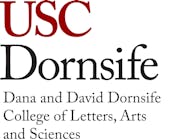
USC Dornsife College of Letters, Arts and Sciences

USC Dornsife College of Letters, Arts and Sciences is the heart of the University of Southern California. The largest, oldest and most diverse of USC’s 19 schools, USC Dornsife is composed of more than 30 departments and dozens of research centers and institutes. USC Dornsife is home to approximately 10,000 undergraduate and graduate students and more than 750 faculty members with expertise across a spectrum of academic fields.
Our frontline scholars are working to find solutions to society’s toughest challenges by advancing human health, preserving and improving our environment, and strengthening our communities. Together, we are defining scholarship of consequence for the 21st century.
Links
Displaying 61 - 80 of 276 articles

Tactical nuclear weapons were designed to be used on the battlefield rather than for strategic defense, but that doesn’t mean there’s a plausible case for using them.

Ada Limón is the first woman of Mexican ancestry to be named U.S. poet laureate. Through her understanding of social media and the power of connection, she strives to make poetry accessible to everyone.

The US is seeing more campaigns to ‘protect’ children by barring controversial books. But research shows children’s reading experiences are complex and unpredictable, explains a literature professor.

A nuclear nonproliferation expert explains why Iran was always unlikely to return to the 2015 international agreement that limited its nuclear weapon development.

Holocaust scholars long relied on documents and survivor testimonies to help reconstruct the history of that tragic event. Now, they’re turning to wordless witnesses to learn more: pictures.

What are classified documents? Who gets to see them? What happens if they are released?

Understanding and changing the environment in which habits form is a critical step when it comes to breaking unwanted behaviors and forming healthy ones.

The word ‘neoliberal’ gets thrown around a lot, often with differing and even contradictory meanings. Here, a political economist explains the origins and evolution of this complex concept.

From figuring out where memories are stored to how sensory information translates to behavior, new technologies are helping neuroscientists better understand how the brain works.

Models shows that some 4 million people in the US have lost a grandparent to COVID-19. But until now, there has been a dearth of research into the mental health effects of losing a grandparent.

Joe Biden is set to make his first visit as president to the Middle East, during which he will meet the Saudi crown prince the US accuses of ordering the murder of a journalist.

A 1972 report warned that unchecked consumption could crater the world economy by 2100. Fifty years and much debate later, can humanity innovate quickly enough to avoid that fate?

COVID-19 deaths tend to be more unexpected and traumatic than other types of deaths. A sociologist explains the mental health burdens facing the millions who’ve lost a relative to the coronavirus.

Many religions have been used to prop up nationalism, and Catholicism is no exception, as a Jesuit priest and scholar explains.

Sandwiched between Russia and NATO ally Norway, both Sweden and Finland have maintained neutrality in global conflicts. That changed in February 2022, when Russia invaded Ukraine.

Thanks to humans, the concentration of planet-warming carbon dioxide in the atmosphere is now 50% higher than before the industrial era. These gases are raising Earth’s temperature.

In a 6-3 conservative majority, the more important divisions may be among the six Republican-appointed justices.

Bongbong Marcos is the projected winner of the Philippines election. That the son of a brutal dictator has won shows how wedded the country is to dynastic politics – and image manipulation.

Planet kerdil di Tata Surya kita dingin, gelap, jauh, dan penuh kejutan.

A folklorist explains the prehistoric origins of the mythical Easter Bunny and why this longstanding cultural symbol keeps returning each spring.
